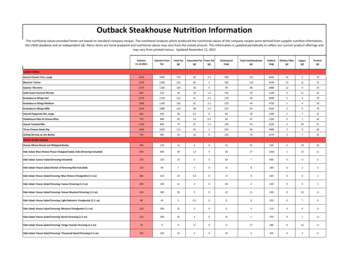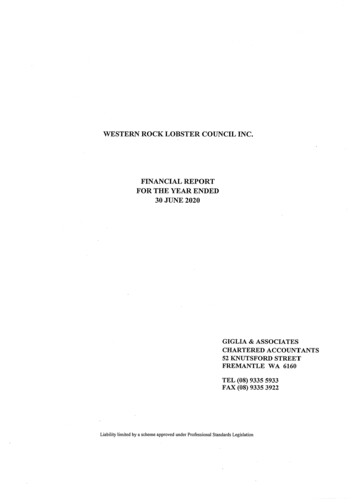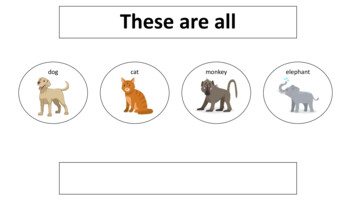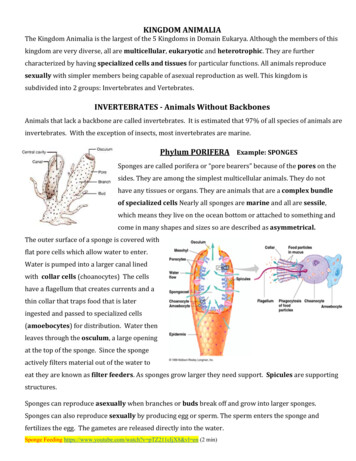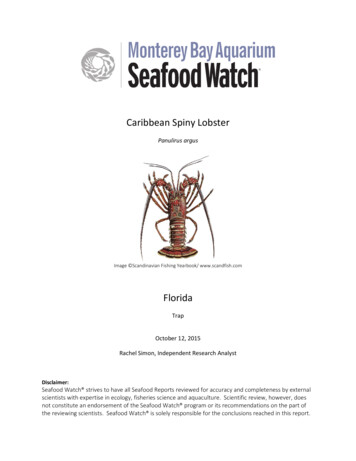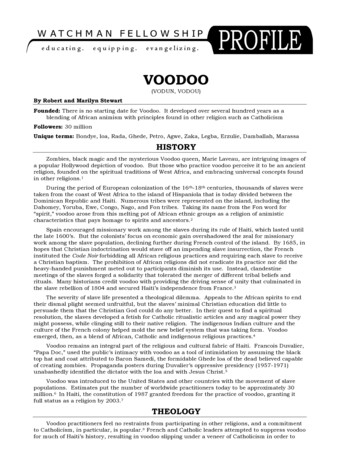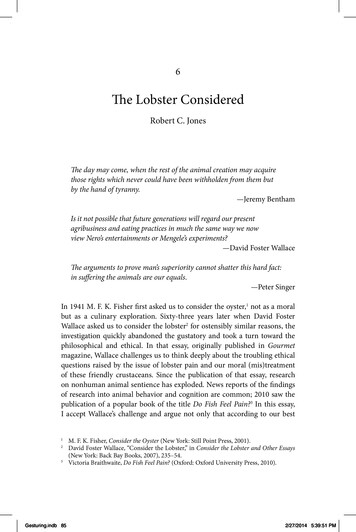
Transcription
6The Lobster ConsideredRobert C. JonesThe day may come, when the rest of the animal creation may acquirethose rights which never could have been withholden from them butby the hand of tyranny.—Jeremy BenthamIs it not possible that future generations will regard our presentagribusiness and eating practices in much the same way we nowview Nero’s entertainments or Mengele’s experiments?—David Foster WallaceThe arguments to prove man’s superiority cannot shatter this hard fact:in suffering the animals are our equals.—Peter SingerIn 1941 M. F. K. Fisher first asked us to consider the oyster,1 not as a moralbut as a culinary exploration. Sixty-three years later when David FosterWallace asked us to consider the lobster2 for ostensibly similar reasons, theinvestigation quickly abandoned the gustatory and took a turn toward thephilosophical and ethical. In that essay, originally published in Gourmetmagazine, Wallace challenges us to think deeply about the troubling ethicalquestions raised by the issue of lobster pain and our moral (mis)treatmentof these friendly crustaceans. Since the publication of that essay, researchon nonhuman animal sentience has exploded. News reports of the findingsof research into animal behavior and cognition are common; 2010 saw thepublication of a popular book of the title Do Fish Feel Pain?3 In this essay,I accept Wallace’s challenge and argue not only that according to our best123Gesturing.indb 85M. F. K. Fisher, Consider the Oyster (New York: Still Point Press, 2001).David Foster Wallace, “Consider the Lobster,” in Consider the Lobster and Other Essays(New York: Back Bay Books, 2007), 235–54.Victoria Braithwaite, Do Fish Feel Pain? (Oxford: Oxford University Press, 2010).2/27/2014 5:39:51 PM
86Gesturing Toward Realityscience do lobsters feel pain, but also that in light of these findings, the moralstatus of lobsters—and all crustaceans—is higher than most people imagineand that they are entitled to membership in the moral community.Moral status explainedWhen we reflect upon the concept of moral status and contemplate whatit means for a being to possess moral status, we imagine a being whoseinterests must be considered in our moral deliberations. In this sense, thenotion of moral status can be thought of as a kind of threshold phenomenon.You either have moral status or you don’t; you’re either in the club or you’renot. Until the last century, philosophers have taken for granted that moralstatus in this sense is primarily a human affair.4 (I’ll have more to say onthis anon.)But there is another way to make sense of the concept of moral status,one that assumes not an all-or-nothing game but rather gradations of moralstatus. For instance, it makes perfect sense to claim that one being has greatermoral status than another, that, for example, a normal adult chimpanzeehas greater moral status than an oyster. Used in this sense, “moral status”specifies not only which entities belong to the moral community, but also thedegree to which their interests count.These two senses of moral status reflect a distinction between whatphilosophers call “moral considerability” and “moral significance.”5 A beingis morally considerable just in case she is a bona fide member of the moralcommunity, thus making it possible for her to be wronged in a morally relevantway. In other words, if a being is morally considerable, she is in the moralclub. In this sense, the fact that a being is morally considerable places a moraldemand on us—or more precisely, on anyone who is capable of recognizinghis or her moral obligations. Once a being is morally considerable, we maythen need to adjudicate questions of relative moral value between kinds ofanimals, for example, between, say, a chimpanzee and an oyster. Thus, moralsignificance involves the moral value of the members once admitted to themoral club.45Gesturing.indb 86The notion of moral status (or moral standing) is modeled on the notion of legal standing.The seminal work on this concept as applied to nonhuman nature is Richard Stone’s“Should Trees Have Standing—Toward Legal Rights for Natural Objects,” SouthernCalifornia Law Review 45 (1972): 450–502.To my knowledge, this distinction was first made by Goodpaster in his “On BeingMorally Considerable,” The Journal of Philosophy 75, 6 (1978): 308–25.2/27/2014 5:39:52 PM
The Lobster Considered87Lori Gruen provides us with a nice metaphor here.6 To establish that abeing—any being (a human, a chimpanzee, a lobster, or even a Martian)—ismorally considerable (i.e., that it matters morally) is to say that it shows upon our “moral radar screen.” But once a being makes it onto our moral radarscreen, questions of moral treatment and adjudication of disputes betweenmembers become a function the being’s moral significance, that is, the strengthof the signal and its location on the moral screen. The strength of one’s moralsignal is determined by those features and capacities deemed valuable bythings like one’s moral theory (and certain other complex factors).7For utilitarian philosophers such as Peter Singer, all that is required fora being to gain entrance into the moral community is sentience,8 that is,the capacity for pain and suffering (or pleasure).9 Beyond sentience, Singersites capacities such as anticipation, detailed memory, and self-awareness,the possession of which may weight moral significance beyond meresentience.Arguing not from a utilitarian stance but from one of inherent rights, TomRegan argues that the capacity to be the subject of experiences, that is, tobe a “subject-of-a-life,” is what matters morally.10 For Regan, individuals aresubjects-of-a-life if they possess the ability to experience feelings of pleasureand pain, the capacity for beliefs, desires, perceptions, memory, an emotionallife, etc.Although the two moral theories differ in the role that these criteria playin determining things such as interests, rights, and obligations, what boththeories agree on is the moral importance of the possession of the abilityto have experiences—a what it’s like to be that thing—to a being’s moral678910Gesturing.indb 87Lori Gruen, “The Moral Status of Animals,” The Stanford Encyclopedia of Philosophy(Winter 2012 Edition), Edward N. Zalta (ed.), ries/moral-animal/.See Bernice Bovenkerk and Franck L. B. Meijboom, “The Moral Status of Fish. TheImportance and Limitations of a Fundamental Discussion for Practical Ethical Questionsin Fish Farming,” Journal of Agricultural and Environmental Ethics 25 (2012): 843–60, fora nice discussion of this distinction.Peter Singer, Animal Liberation (New York: HarperCollins, 2009).‘Sentience’ can mean different things to different people including things like thepossession of a certain type of subjectivity or self-awareness. However, in the animalethics literature, sentience is a term of art denoting only the capacity for pain andsuffering (or pleasure). Some people (e.g., Descartes) argue that suffering requiressomething beyond mere sentience, something more complex, a kind of second-orderawareness of the self. However, (a) that’s not what philosophers writing on animal rightsmean by the term, and (b) were that the case, newborn human infants would most likelylack the ability to suffer, and that seems implausible. See my paper “Science, Sentience,and Animal Welfare,” Biology & Philosophy 28, 1 (2013): 1–30, for details.Tom Regan, The Case for Animal Rights (Berkeley and Los Angeles: University ofCalifornia Press, 2004).2/27/2014 5:39:52 PM
Gesturing Toward Reality88considerability. For example, according to Peter Singer’s sentientist view,once a being is determined to be sentient, she just is morally considerable.Given this brief background, we can now get clearer on the focus of thisessay. The focus of this essay is not on the moral significance of any oneindividual lobster, nor of any one species of lobster. Nor even of crustaceansas a whole. This is not an essay whose purpose it is to adjudicate whether alobster has greater moral significance than a human or a chimpanzee or asnail or a flea. This is not an exploration of moral significance at all.Given that globally we catch, boil alive, and eat about 200 million lobstersannually,11 when asked to consider the lobster, the issue is certainly not oneof moral significance, but of moral considerability since lobsters currentlystand outside the moral community. In considering the lobster, the questionis whether these “Alien-like” crustaceans of Jurassic origin should join usin the club of beings that are morally considerable. In the remainder of thisessay, I argue that lobsters are morally considerable, that they should be “inthe club,” that they should show up on our moral radar screen, that they areindeed members of the moral community.A little argumentHere’s a little argument:1. Possession of the capacity for pain and suffering makes the possessormorally considerable.2. Lobsters possess the capacity for pain and suffering.3. Therefore, lobsters are morally considerable.11Gesturing.indb 88Since statistics on lobster “production” (as with figures on the production for food of pigs,cows, chickens, or any land animal) are reported not by the number of actual animalscaught (or, in the case of land animals, slaughtered) but by total weight, determiningthe number (or even an approximation of the number) of lobsters caught globally peryear—a figure known as “annual global capture production”—requires a bit of math.According to the folks who keep track of such things, namely the Food and AgricultureOrganization of the United Nations, about 280,364 tonnes (known in the US as “metrictons”) of lobster are captured each year. Converting tonnes to tons (known in the US as“tons” and in the non-US as “short tons”) we get a figure of about 309,000 tons of lobstercaptured globally every year. That’s about 600 million pounds of lobster. Now, accordingto Encyclopedia.com, the average lobster weighs about 3 pounds. That means thatglobally, about 200 million lobsters are caught each year. Imagine what would happen ifthe figures on humans killed annually due to genocide, war atrocities, plane crashes, carwrecks, and the like were reported by total weight instead of number of lives lost. By thismeasure, Stalin murdered—or perhaps we should say, “produced”—about 1.5 milliontons of humanity.2/27/2014 5:39:52 PM
The Lobster Considered89Obviously this argument is valid. The question is whether it is sound. Thatis, are (1) and (2) true? And how might we answer these questions? (1) isa normative claim, a claim of value; (2), an empirical claim. Personally,I think that (1) is rather uncontroversial and needs little if any argument.Nevertheless, later in the essay, I address an objection to (1). That said, if youbuy the truth of (1), then the conclusion rests solely on the truth of (2). Andsince (2) is an empirical question, in arguing for (2) I will marshal our bestscience on crustacean pain.Now I’m sure some may see the conclusion of our little argument asobvious and this task unnecessary. However, although René Descartesfamously (or notoriously, depending on who you ask) denied animalsentience way back in the seventeenth century,12 a number of contemporaryphilosophers (believe it or not) still maintain that nonhuman animals lackthe capacity to feel anything at all, let alone suffer.13 But it’s time to leavebehind implausible views and turn to the task at hand.Animals and the moral landscapeMorality-wise, Western philosophical theory has been constructed onthe belief that humans are the proper subjects of moral concern becauseonly humans occupy a moral sphere separate from and superior to that ofthe nonhuman animals. This view, the accepted view—a view known ashuman exceptionalism—commits us to two theses. The first is the claim thathumans are unique in their possession of some capacity (or set of capacities)within the physiological or cognitive domains. The second is the claim thatthe possession of such capacities makes all and only humans morally superiorto beings (such as nonhuman animals) who lack such capacities. Importantly,the first claim is largely empirical, and the second, normative. These twoclaims constitute the two fronts on which those philosophers seeking toexpand the moral status of nonhuman animals mount their attacks in anattempt to dismantle the foundations of human exceptionalism.Central to the strategy employed by philosophers who seek to underminehuman exceptionalism and increase the moral status of animals has been to1213Gesturing.indb 89Though this is the “standard” interpretation of Descartes, recently my colleague JosephHwang has come to convince me that perhaps this is too simplistic an interpretation,overstating the case. See also, Peter Harrison, “Descartes on Animals,” The PhilosophicalQuarterly 42 (1992): 219–27 and Robert Jones, “The Moral Significance of AnimalCognition” (PhD diss., Stanford University, 2005).See, for example, Peter Harrison, “Do Animals Feel Pain?,” Philosophy 66 (1991): 25–40,and Peter Carruthers, The Animals Issue (Cambridge: Cambridge University Press, 1992).2/27/2014 5:39:52 PM
90Gesturing Toward Realityattack the empirical aspects of human exceptionalism by presenting evidencethat demonstrates the possession by some nonhuman animals of some set ofmorally relevant physiological or cognitive capacities. When successful,arguments of this kind undermine the first prong of the human exceptionalismthesis. Thus, the strategy for those philosophers like Singer and Regan hasbeen to question the existence of a clear distinction between all humans andall animals with regard to the possession of morally relevant capacities suchas sentience and other what-it’s-like experiences. These candidate capacities—sentience, self-awareness, memory, and mindreading14—although not theonly capacities that might bear on the moral status of individuals, represent asolid starting place. Since as we’ve seen, the first claim that undergirds humanexceptionalism—the claim that humans are unique in their possession ofsome set of morally relevant capacities—is primarily an empirical one, itis quite useful—and in some cases, indispensable—to see what science hasto say about which animals possess which capacities. Thus, the empiricaldata on this question are central to the question of the moral status, moralconsiderability, moral significance, and moral treatment of nonhumananimals. For example, with regard to sentience, if no clear distinction canbe empirically drawn between humans and animals, then the foundations ofhuman exceptionalism will be substantially weakened and the moral status ofnonhuman animals increased.A cautionary noteAlthough the possession of the capacity for pain and suffering is crucial indetermining which things among the furniture of the universe are the properobjects of moral concern, some caution is in order. Since our epistemicaccess to the mental lives of animals is even more limited than access to eachother’s minds, we must be cautious about cognitive attributions, and selectiveabout the kinds of evidence for such attributions we have at our disposal.As Wallace notes, reliance on comparative neuroanatomy as a basis for themoral considerability of animals can be fraught:Since pain is a totally subjective mental experience, we do not havedirect access to anyone or anything’s pain but our own; and even justthe principles by which we can infer that others experience pain and have14Gesturing.indb 90When philosophers talk about mindreading, they’re not talking about telepathy, theymean merely the ability to attribute mental states (e.g., beliefs and desires) to others andthe understanding that others’ beliefs and desires may differ from one’s own.2/27/2014 5:39:52 PM
The Lobster Considered91a legitimate interest in not feeling pain involve hard-core philosophy—metaphysics, epistemology, value theory, ethics. The fact that eventhe most highly evolved nonhuman mammals can’t use language tocommunicate with us about their subjective mental experience is only thefirst layer of additional complication in trying to extend our reasoningabout pain and morality to animals. And everything gets progressivelymore abstract and convolved as we move farther and farther out fromthe higher-type mammals into cattle and swine and dogs and catsand rodents, and then birds and fish, and finally invertebrates likelobsters.15Although Wallace too quickly assumes that pain is a “totally subjectiveexperience,”16 he makes clear some of the philosophical challenges ofattributing pain to beings other than ourselves. (I will return to this issuelater in the essay.) A further worry involves numbers. Only a small fractionof the almost 6,000 extant mammalian species, 10,000 avian species,tens of thousands of reptile and amphibian species, a still greater numberof fish species, and millions of insects and spiders have been investigatedfor sentience. Despite these challenges, comparative biological methodsremain the most reliable metric in our understanding of the mental lives ofnonhuman animals.Sentience: Pain and suffering17A solid methodological framework for an investigation into whether ananimal is sentient includes investigating whether that animal possesses orexhibits151617Gesturing.indb 91Wallace, Consider the Lobster, 246.Surprisingly, Wallace’s assumption here, which reflects intuitive, pre-theoretic notions ofpain—that access to my own internal pain states is a solely introspective affair involvingprivate, subjective experiences about which my epistemic judgments are immuneto error and about which I cannot be wrong—can lead to some strange, unintuitiveconsequences. For example, if my pain sensation is physical (which seems the case),it follows that it is both located in physical, public space and yet logically private, anodd consequence indeed. Yet, if pain is not physical, what sort of thing could it be? Anon-spatial, non-physical, spatiotemporally located event? But what might that be? Thephilosophical literature on the subjectivity of pain is enormous. If you’re interested, youshould start with Murat Aydede’s entry “Pain” in the Stanford Encyclopedia of Philosophy(Aydede, Murat, “Pain,” The Stanford Encyclopedia of Philosophy (Spring 2013 Edition),Edward N. Zalta (ed.), forthcoming ries/pain/.)See my (2013) for a detailed discussion of animal sentience.2/27/2014 5:39:52 PM
92 Gesturing Toward Realitya central nervous system and other structures and psychoactivechemicals homologous to those known to control pain responsein humans (e.g., neuroanatomical (opioid receptors, such asnociceptors) and neurochemical (opioids, such as endorphins andencephalins))18physiological or behavioral response to noxious19 (or positive) stimuli,analgesics, and anesthetics.20Although at first glance these properties and capacities may seem to providea clear framework for investigation, as we’ve already seen, difficulties quicklyarise. Pain is a notoriously difficult phenomenon to understand, not only inourselves but especially in nonhuman animals.21 Data on pain present at leasttwo challenges.22The first is that data on the high variability between the physiologicalmechanisms and the phenomenal aspects of pain are often confounding,raising puzzles about the connection between the two. For example, thevery same kind of stimuli can elicit a pain response of widely varyingintensity (or none) in different individuals or even in the same individualat different times, making generalizations from humans to animals evenmore challenging. Although we have a good idea of how the nervous systemdetects and responds to painful events in humans, exactly how the humanbrain processes the stimuli and generates the phenomenal aspects of paininduced by injury remains far less clear.A second challenge presented by the data on the connection betweenthe physiological mechanisms and the phenomenal aspects of pain isabnormalities such as congenital analgesia or, even more puzzling, pain1819202122Gesturing.indb 92Endorphins and encephalins are two of the more common substances—found in manyorganisms—known to have morphine-like analgesic effects.Noxious stimuli used in pain research on nonhumans include “mechanical” (pricking orprobing), “thermal” (heating or freezing), “chemical” (exposure to acidic irritants), and“electrical” (shocking).Marian Dawkins (2006) presents a clear and persuasive analysis of the scientific basisfor assessing suffering in animals, highlighting the plurality of mental states that mightbe properly described as “suffering,” and thus somewhat vaguely (and I think, wisely)characterizes suffering as the “experiencing [of] one of a wide range of extremelyunpleasant subjective (mental) states,” a definition I wholly endorse.For clear discussions of some of the difficulties peculiar to assessing animal pain,see Collin Allen’s, “Animal pain,” Nous 38, 4 (2004): 617–43 doi:10.1111/j.00294624.2004.00486.x, as well as his “Deciphering animal pain,” in Pain: New Essays on ItsNature and the Methodology of Its Study (Cambridge, MA: Bradford Book/MIT Press,2005).For a nice discussion of the difficulties in finding a unified theory of pain, see theIntroduction to Aydede’s Pain: New Essays on Its Nature and the Methodology of Its Study(Cambridge, MA: MIT Press, 2005).2/27/2014 5:39:52 PM
The Lobster Considered93asymbolia, a type of dissociation affect involving pain without painfulness.In these bizarre, almost inconceivable cases, a subject feels pain but is notin pain.23Given these challenges, how might our investigations into the questionof animal pain reliably proceed? Common sense suggests that at leastmammals and birds are sentient. But what about reptiles? Amphibians?Fish? Invertebrates? Do lobsters feel pain when boiled alive? Scallops, whenshucked? Cockroaches, when blasted with insecticide? Here, intuitions beginto break down, and so it seems only science can step in where commonsenseintuitions begin to falter.24What exactly is pain?25The International Association for the Study of Pain (IASP) provides whatseems at first blush to be a reasonable definition of pain as “an unpleasantsensory and emotional experience associated with actual or potentialtissue damage, or described in terms of such damage.” The IASP definitionis followed by a footnote informing us that “pain is always subjective”and that the IASP definition intentionally “avoids tying pain to thestimulus.”26 However, the IASP definition of pain is both physiologically andphilosophically problematic since it (a) emphasizes subjective experienceand self-report while supporting conflicting philosophical interpretations ofpain (e.g., subjectivist and objectivist views of pain), and (b) remains silenton the question of the relationship of the physiological bases of pain to itsphenomenal aspects. Yet, given that pain and suffering are likely very old23242526Gesturing.indb 93In his fascinating 2007 book Feeling Pain and Being in Pain, Nikola Grahek presentsa quite thorough analysis of the empirical literature on such pain abnormalities andthe implications of such data for the “hard problem” of consciousness in the contextof pain. Some of these cases are truly bizarre and mind-blowing. For example, Grahekdiscusses cases of people experiencing pain asymbolia who, after suffering brain trauma(or sometimes just people who have been given a whopping dose of morphine), reportthat they are experiencing pain but are just not bothered by it. That is, they recognize thesensation of pain but are completely immune to suffering from it.See the World Society for the Protection of Animals (WSPA) website “Sentience Mosaic”http://www.animalmosaic.org/sentience/ for an exhaustive number of resources on thescientific literature on nonhuman animal sentience and its connection to animal welfareissues.The focus here is primarily on physical pain, not emotional or psychic pain, though thedistinction between the two is not at all clear. Anyone who has suffered severe grief orheartache knows how much they can really physically hurt.H. Merskey and N. Bogduk, Classification of Chronic Pain: Descriptions of Chronic PainSyndromes and Definitions of Pain Terms, 2nd edn (Seattle: IASP Press, 2011).2/27/2014 5:39:52 PM
94Gesturing Toward Realityphenomena, it would be strange were pain not widespread across variedspecies, did not provide selective advantage, nor serve a similar adaptivefunction as it does in humans. In other words, it would be very surprisingif we were the only animals that experienced pain. Consequently, anunderstanding of the basic mechanics of pain is imperative to understandingits role in animal sentience.The mechanics of painPain in humans is at least a two-step process. The first step involves thestimulation of special receptors called nociceptors that transmit injurydetecting electrical impulses to the spinal cord, triggering an automatic reflexresponse. At this first stage, there are no conscious, phenomenal aspects ofthe experience. In the second stage, the signal then moves from the spinalcord to the neocortex at which point the phenomenal aspects of pain kick inand we experience the unpleasant sensation associated with tissue damage.Although researchers are clear about the mechanisms involved in the firststage, it is the second stage of the process—the conscious experience ofpain—that remains somewhat of a mystery.In addressing the issue of animal pain, we can start with the questions,“Which animal groups possess nociceptors (or exhibit a ‘nociceptiveresponse’)?” and “Do they (and if so, how do they) respond to noxious stimuli,analgesics, and anesthetics?” We can further explore which organisms possessneural organs more complex than simple neural nets (e.g., organs such asganglia, brain masses, or brains), and of these, which possess nociceptor-tobrain pathways. It is time now to turn to the evidence.Do lobsters feel pain?A lobster, taxonomically speaking, is a marine crustacean of the familyHomaridae, characterized by five pairs of jointed legs, the first pairterminating in large pincerish claws used for subduing prey. Moreover, acrustacean is an aquatic arthropod of the class Crustacea, which comprisescrabs, shrimp, barnacles, lobsters, and freshwater crayfish. All this is rightthere on Wikipedia. And an arthropod is an invertebrate member of thephylum Arthropoda, whose phylum covers insects, spiders, crustaceans, andcentipedes/millipedes, all of whose main commonality, besides the absenceof a centralized brain-spine assembly, is a chitinous exoskeleton composedof segments, to which appendages are articulated in pairs. The point isGesturing.indb 942/27/2014 5:39:52 PM
The Lobster Considered95that lobsters are basically giant sea-insects.27 Given that, a slight digressioninvolving a review of what our best science has to say about sentience ininsects may enhance our understanding of the same in crustaceans.28Insects and spidersThe literature on insect and arachnid pain is astonishingly impoverished.For over 30 years, the established view (made so by one Sir Prof. VincentBrian Wigglesworth)29 has been that insects by in large do not feel pain. Yet,Wigglesworth goes on to argue that certain insect behaviors (e.g., escapebehavior when presented with noxious stimuli) indicate that some insectsmust experience some form of pain. Eisemann et al.30 conclude that theevidence “does not appear to support the occurrence in insects of a painstate.”31 However, Tracey et al.32 and Tobin and Bargmann have discoverednociception in at least some insects, namely Drosophila.33 Neely et al. findnociception in response to thermal noxious stimuli as well as what theresearchers refer to as a “pain” gene in Drosophila.342728Factoid: A lobster’s blood is colorless but when exposed to oxygen develops a bluish color.This FN will almost surely not survive the editing process, but here goes:The observant reader may notice that this paragraph is taken almost word-for-wordfrom DFW’s own lobster essay. Were I to use quotes and then cite as is customary,the somewhat Wallacean subversive intent of this paragraph would be lost entirely(though perhaps the very insertion of this FN might undermine that intent). In anyevent, I have chosen to drop this FN acknowledging the origin of this paragraph toavoid the conventional the quote-and-cite option. In fact, even the idea of dropping aFN of this kind is borrowed from DFW. Though it is highly doubtful that the lobsteris capable of such recursive meta-thinking, fortunately its moral considerabilitydoes not depend upon the possession of these kinds of cognitive abilities.293031323334Gesturing.indb 95V. Wigglesworth, “Do Insects Feel Pain?” Antenna 1 (1980): 8–9.C. H. Eisemann, W. K. Jorgensen, D. J. Merritt, M. J. Rice, B. W. Cribb, P. D. Webb andM. P. Zalucki, “Do Insects Feel Pain?—A Biological View,” Cellular and Molecular LifeScience 40, 2 (1984): 164–7.Despite Eisemann et al.’s conclusion that the evidence “does not appear to support theoccurrence in insects of a pain state,” tellingly, he advises the “experimental biologist . . . tofollow, whenever feasible, Wigglesworth’s recommendation that insects have theirnervous systems inactivated prior to traumatizing manipulation. This procedure notonly facilitates handling, but also guards against the remaining possibility of paininfliction and, equally important, helps to preserve in the experimenter an appropriatelyrespectful attitude towards living organisms whose physiology, though different, andperhaps simpler than our own, is as yet far from completely understood.”W. D. Tracey, R. I. Wilson, G. Laurent and S. Benzer, “painless, a Drosophila GeneEssential for Nociception,” Cell 113, 2 (2003): 261–73.D. M. Tobin and C. I. Bargmann, “Invertebrate Nociception: Behaviors, Neurons andMolecules,” Journal of Neurobiology 61, 1 (2004): 161–74.G.
1 M. F. K. Fisher, Consider the Oyster (New York: Still Point Press, 2001). 2 David Foster Wallace, “Consider the Lobster,” in Consider the Lobster and Other Essays (New York: Ba
